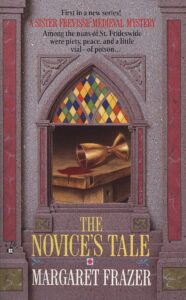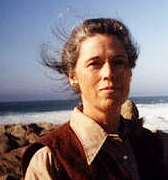By Margaret Frazer; reviewed by Jeannette Hartman
 The peace and beauty of grain ripe for harvest surround St. Frideswide’s priory in September 1431. Thomasine, a novice due to make her final vows in two weeks, is bringing honey cakes to Domina Edith’s room. Thomas Chaucer, a powerful member of Parliament and son of poet Geoffrey Chaucer, has stopped in to pay a visit to his niece Dame Frevisse.
The peace and beauty of grain ripe for harvest surround St. Frideswide’s priory in September 1431. Thomasine, a novice due to make her final vows in two weeks, is bringing honey cakes to Domina Edith’s room. Thomas Chaucer, a powerful member of Parliament and son of poet Geoffrey Chaucer, has stopped in to pay a visit to his niece Dame Frevisse.
Soon, the noisy, chaotic and unexpected arrival of Lady Ermentrude Fenner breaks the peace. She was recently released from service as a lady-in-waiting to the Dowager Queen Catherine. She is Thomasine’s dreaded great-aunt, who has always opposed her entering the convent and repeatedly threatens to take her away by force and marry her off.
Scarcely are the tea, cakes and conversation in Domina Edith’s room finished than Lady Ermentrude announces that she is leaving to pay a visit to Lady Isobel Wykeham, Thomasine’s sister.
When Lady Ermentrude returns the next day, she is staggering, apparently drunk, angry and raving. As the nuns settle her in a darkened bed chamber. Isobel and John Wykeham ride in concerned about her condition.
By that night, one of the lay women attending her, Martha Hayward, who once was in Lady Ermentrude’s service, is dead with symptoms similar to Lady Ermentrude’s. By the following morning Lady Ermentrude is also dead. Both women had had wine to which infirmarian Dame Clare had added soothing herbs. They had also had milk sops, a mixture of warm milk, bread and honey that Thomasine had brought from the kitchen.
Rumors ricochet through the priory: was it Lady Ermentrude’s heart? Brain fever? Too much drink? Years of over-indulgence? Apoplexy? Possession by demons?
Crowner Morys Montfort wants a quick and simple answer for the two deaths. He’s a busy man. That hope is dashed when Dame Clare announces that both women were poisoned. Sir Walter Fenner, Lady Ermentrude’s son arrives from the deathbed of his uncle. He also wants quick answers so he can return to his dying uncle’s bedside and protect his place in his uncle’s will.
Sir Walter points the finger at Thomasine, who brought in the milk sops and wine and whose desire to remain in the convent gave her motive to murder her hated great-aunt.
It’s up to Dame Frevisse to discover what actually happened.
This is a fascinating murder investigation set in a time when people were as willing to believe a person was murdered by demons as they were to believe in a human killer. There are plenty of suspects here, some of whom have roles on a much larger stage than St. Frideswide. Dame Frevisse’s quick wits and powers of reasoning and observation identify the culprit just before another tragedy unfolds.
Anyone who enjoys the Brother Cadfael mysteries, will enjoy the Dame Frevisse mysteries. The Cadfael mysteries take place between 1135 and 1145, while the Dame Frevisse mysteries are set between 1432 and 1452.
Author Margaret Frazer has taken the style of Geoffrey Chaucer’s CANTERBURY TALES to write a series of mysteries, each of which opens from the point of view of a different player from the world in and around the St. Frideswide priory.
THE NOVICE’S TALE (1992) was followed by:
- THE SERVANT’S TALE (1993)
- THE OUTLAW’S TALE (1994)
- THE BISHOP’S TALE (1994)
- THE BOY’S TALE (1995)
- THE MURDERER’S TALE (1996)
- THE PRIORESS’ TALE (1997)
- THE MAIDEN’S TALE (1998)
- THE REEVE’S TALE (1999)
- THE SQUIRE’S TALE (2000)
- THE CLERK’S TALE (2002)
- THE BASTARD’S TALE (2003)
- THE HUNTER’S TALE (2004)
- THE WIDOW’S TALE (2005)
- THE SEMPSTER’S TALE (2006)
- THE TRAITOR’S TALE (2007)
- THE APOSTATE’S TALE (2008)
Six of the novels are set at the priory or the neighboring village. In others, Dame Frevisse leaves the convent to accompany another nun on some family or convent business or business of her own. In some of the later novels, Frevisse is an observer of historical events and people that brought on the Wars of the Roses.
The Author: Margaret Frazier
 Initially, Margaret Frazier was the pen name of Gail Lynn Brown and Mary Monica Pulver Kuhfeld, who collaborated on the first six books in the Dame Frevisse series.
Initially, Margaret Frazier was the pen name of Gail Lynn Brown and Mary Monica Pulver Kuhfeld, who collaborated on the first six books in the Dame Frevisse series.
The two met in the 1980s as members of the Society for Creative Anachronism, an organization in which members adopt medieval personas. Both chose 15th century characters: Kuhfeld a nun and Frazer the widow of a wealthy Yorkshire merchant.
Kuhfeld had been asked by her publisher to write a medieval mystery. Frazer had gathered lots of information but couldn’t get a book published. Together they produced THE NOVICE’S TALE, published in 1992, and six other Dame Frevisse mysteries, ending with THE MURDER’S TALE.
The partnership ended because they had different visions for the series, although they remained friends. Brown continued to write as Margaret Frazier.
Brown was diagnosed with breast cancer the year that THE NOVICE’S TALE was published. She died Feb. 4, 2013.


